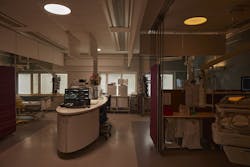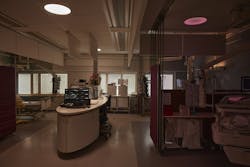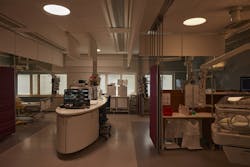Circadian light eases recovery in a Swedish neonatal intensive care ward
A hospital in Uppsala, Sweden has installed LED-based circadian lighting in its neonatal intensive care ward, where parents and staff say the softer and controllable tones have fostered a calm environment that helps premature and full-term babies develop and recover.
“What these patients have in common is that they are particularly sensitive to light, which the ward's previous lighting solution was not adapted for,” said a spokesperson for Chromaviso, the Danish supplier of some 200 luminaires covering around 11,000 square feet across areas including incubators and administrative and common spaces at Uppsala University Hospital.
Indeed, prior to switching on the Chromaviso system in December 2022, the hospital — also known as Akademiska Hospital — applied more primitive methods to minimize the brightness and glare of what was standard lighting.
"Before, we always tried to dim the light around the patient by using a blanket over the incubators to shield the baby,” said Jenny Lötberg, an anesthesia and intensive care nurse at the facility. “If we couldn't use a blanket to protect against light in the incubators, we always made sure to shield the patients' eyes in other ways so that the light didn't shine directly into them. However, with the circadian lighting, it has become much easier because the customized light settings are much better for premature babies than regular white light.”
Circadian lighting, which is also known as human-centric lighting, generally provides illumination that mimics the daily spectral and intensity patterns of the sun, with the stimulating brightness and blues of midday giving away to relaxing, subdued, warm orange tones prior to night.
Many circadian systems such as Chromaviso’s can be tailored to suit different needs and environments. For example, Akademiska and Chromaviso have set lighting over incubators to dim at midday in order to facilitate naps. Under normal circadian circumstances, lighting at that time of day would be bright and stimulating at a blue-rich 6000K.
"We need different lighting functions depending on whether it's an intensive care room, an intermediate care room, or a staff area,” Lötberg said. “In staff areas, we need slightly brighter lighting, while it should be a bit more subdued in the intensive care rooms. With circadian lighting, we feel that the lighting is much more adapted to our activities in the department compared to the lighting we had before.”
Controls include both central computer screens as well as wall-mounted buttons that allow a overriding. Parents have been using the wall controls to dial up pink light, which they consider to be calming.
Although clinical results of patient improvement or of the effect of pink light in the ward are not yet available, anecdotally the system has improved the environment.
“It provides a natural transition between day, evening, and night, creating a better treatment environment for patients and their parents,” Lötberg said. “Even the staff has benefited from circadian lighting, with several employees reporting less headache and better sleep quality after evening and night shifts.”
Aarhus-based Chromaviso said installation, with Uppsala electrical contractor Sallén Elektriska, ran from October to December of last year during which the ward continued to operate. Chromaviso declined to reveal pricing.
More on circadian lighting
How the industry can standardize circadian lighting
Circadian study in dementia-care setting will also focus on user experience
Tunability linked to lighting energy efficiency
MARK HALPER is a contributing editor for LEDs Magazine, and an energy, technology, and business journalist ([email protected]).
Follow our LinkedIn page for our latest news updates, contributed articles, and commentary, and our Facebook page for events announcements and more. You can also find us on the X platform.
Mark Halper | Contributing Editor, LEDs Magazine, and Business/Energy/Technology Journalist
Mark Halper is a freelance business, technology, and science journalist who covers everything from media moguls to subatomic particles. Halper has written from locations around the world for TIME Magazine, Fortune, Forbes, the New York Times, the Financial Times, the Guardian, CBS, Wired, and many others. A US citizen living in Britain, he cut his journalism teeth cutting and pasting copy for an English-language daily newspaper in Mexico City. Halper has a BA in history from Cornell University.






![The DesignLights Consortium continues to make progress in shifting outdoor lighting products and implementation practices toward a more restrained and thoughtful strategy. [Image does not represent a DLC qualified fixture.] The DesignLights Consortium continues to make progress in shifting outdoor lighting products and implementation practices toward a more restrained and thoughtful strategy. [Image does not represent a DLC qualified fixture.]](https://img.ledsmagazine.com/files/base/ebm/leds/image/2024/08/66be810888ae93f656446f61-dreamstime_m_265700653.png?auto=format,compress&fit=&q=45&h=139&height=139&w=250&width=250)
